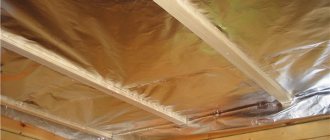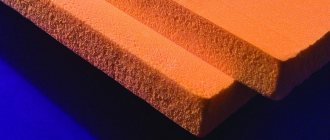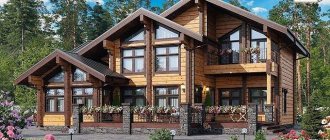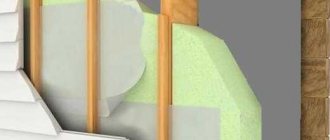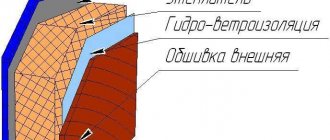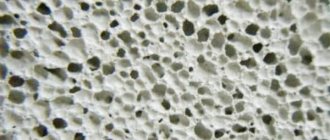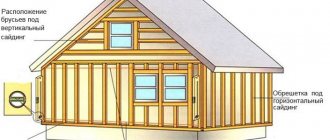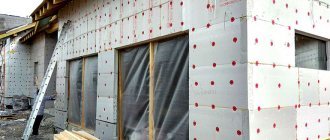Differences between old and new technologies
Wooden construction in Rus' is a centuries-old tradition. For centuries, houses were built exclusively from log houses, from massive round and semicircular logs, the thickness of which was sufficient for good thermal insulation. Just like today, the tree dried out over time, and cracks appeared between the logs. But earlier there were other ideas about the beauty of the facade, so ordinary wood moss was used to caulk cracks. It landed in the cracks between the logs and over time reliably filled the entire space between them.
In modern construction, issues of economy come to the fore and force the use of timber, the thickness of which does not always meet the requirements of the developed standards. If the cross-section is insufficient, complete freezing occurs in winter, which means that the walls of the house are not able to retain heat. In addition, over time, the wood begins to dry out, causing heat loss to increase even more.
This is what a timber wall looks like after the wood has dried Source bredmozga.ru
Heat losses of a house made of timber
Although wood itself is a heat insulator, it is a mistaken belief that thick wooden walls alone will be enough to retain heat inside. Modern construction practice has shown that the best results can only be achieved by combining layers of thermal insulation.
In wooden houses this is easier to do, since a wall made of timber is a fairly uniform layer and, in addition to its load-bearing function, partially prevents heat loss. Thanks to the grooves, the profiled timber eliminates the possibility of blowing through the walls and lengthens the cold bridges; all that remains is to improve the heat-saving characteristics.
First, you need to obtain initial data on heat loss, for which you perform a thermal engineering calculation of the house and scan it in the infrared spectrum. This information will help you select the required thickness of additional insulation to reduce heat loss to the power level of the heating system.
In accordance with SNiP 23–02–2003, the coefficient of heat transfer resistance of the walls of residential buildings is in the range of 4.2–4.9, for which the thickness of a dry wooden wall should be 40–50 cm. This is quite expensive, and besides, homogeneous wood does not tolerate temperature differences well and humidity from different sides. Therefore, the load-bearing layer of the wall is made thinner, for example, from 150x150 mm timber, and the insulation is placed in a separate layer.
As wood is replaced by a less thermally conductive material, the thickness of the latter is reduced in accordance with the difference in thermal conductivity. For example, to insulate a wall made of 150x150 mm profiled timber, a 100 mm layer of extruded PPS or 120 mm glass wool will be sufficient, which will also protect the wood from atmospheric influences.
Advantages and disadvantages of wall insulation in a log house
Thrifty owners are looking for ways to properly insulate a house made of timber so that they can spend less money on heating in winter. This can be done in two main ways: from the inside and from the outside, and external insulation is preferable for a number of reasons.
Features of insulation from the inside
With internal insulation, the positive effect of heat saving is offset by the disadvantages:
- Part of the usable area is inevitably lost due to the installation of a frame under the insulation.
- The thermal insulation layer hides the “living” wooden walls and the rooms lose their unique charm.
- Due to external winter cooling of an unprotected wooden wall, the dew point moves into the internal insulation. Condensation occurs, mold appears, and it is difficult to control the condition of the wood.
External insulation of the building
It is best to insulate the outside of a cobblestone house with your own hands using the “ventilated facade” method.
This technology is currently used everywhere.
- At the time when the log house is assembled and caulked, and the roof is installed, the outside walls of the house are insulated with mineral wool.
- It is best to lay the insulation in two layers, which is 10 cm. Cuts of mats or rolls must be placed “spaced out” so that there are no through gaps.
- The cotton wool needs to be inserted into the cells, between the frame bars.
- On the outside, the insulation must be covered with a membrane-type windproof film. It allows steam to pass through and retains water.
- You need to know that before insulating a log house, the ventilation space must be left on top of the film. It can be created using vertically packed counter batten slats.
- The vents must be cleared from below (at the base) and from above (under the roof overhang). So, air will circulate in the ventilation space, removing excess steam. Based on this, condensation will not settle on the heat insulator.
- The cladding is fixed to the counter lathing: cladding boards, siding, tiles, etc.
Is it necessary to insulate a house made of 200x200 timber?
Experts strongly advise doing this, because... you will receive a number of benefits.
- An insulated building will be quite warm. By spending minimal money on heating the premises, you can achieve a comfortable temperature in them.
- The rooms will warm up evenly.
- In addition to comfort and savings, the life of the building increases.
Note! The timber, which is protected from the outside by a heat insulator and facing material with ventilation, does not experience negative effects from liquids, temperature changes, or solar ultraviolet radiation.
- Another question about whether it is necessary to insulate a house made of 200x200 timber. A ventilated facade will increase the environmental friendliness of the building. Only natural wood will be adjacent to the living rooms; the heat insulator will be moved outside to the ventilation gap. Based on this, the walls will be able to “breathe”.
- The aesthetics of the building also increases. It is possible to first insulate a timber house, and then line it with virtually any material.
Video description
What happens to the wall if the insulation is not properly insulated from the inside - in the video:
Insulation of walls from the outside: advantages and disadvantages of the method
Most often they resort to it, keeping in mind the obvious advantages compared to internal insulation:
- The usable area of the internal space is preserved;
- External work does not change the family's daily routine.
- The facade of the house is reliably protected from sudden temperature changes, which extends the life of the building.
- The correct selection of materials does not disturb the microclimate of the rooms (the house “breathes”).
- You can decorate the facade to your liking or improve the appearance if the wood has darkened over time.
- If the technology is followed, the wood will be additionally protected from damage.
- Ease of monitoring the work of the construction team.
The main disadvantage of external insulation is the need to carry it out in good weather; in cold and damp weather there is no point in doing this.
See also: Catalog of companies that specialize in insulating country houses.
Basic rules for insulating a wooden house from the outside
The beams absorb moisture well, so over time they are subject to severe deformation. Therefore, when insulating the facade of a house so that it can breathe, you should take into account that in this case you need to make a gap for ventilation. This way the moisture will come out and not accumulate. A facing layer will also need to be laid over the insulation. Many builders agree that for a house made of wooden beams, it is best to use the technology of constructing a ventilated façade of the building for insulation.
It includes the installation of materials in the following sequence: a frame is installed on the wall, then the selected heat insulator is placed, a vapor barrier membrane is mounted and a hole for ventilation is made, and the whole thing is covered with facing material.
Regardless of the type of thermal insulation material, the sequence of actions remains the same.
Three main insulation methods
Any insulation of walls involves attaching a layer of insulation and structures holding it to it. Several methods have been developed for this purpose and each of them has its own advantages and implementation features.
The principle of wall insulation is the creation of an additional protective “pie” Source lestorg32.ru
Hinged ventilated facade
This technology itself was developed as a decoration for the facade of a house, but since the installation procedure involves attaching a layer of mineral wool or a similar material to the wall, this method can be considered as insulation.
Advantages of using ventilated facades:
- Long service life (up to 50 years), excellent heat and sound insulation.
- Easy to install.
- Wide selection of facing materials in various colors.
- The dew point moves outward.
Installation technology:
- Pre-treatment of lumber is carried out with compounds that prevent rotting and make the tree unattractive to insects.
- A sheathing is attached to the outside of the house, onto which a sheet of hydro- and wind protection is placed. Air circulates freely in the space between the sheathing slats, due to which condensation or moisture that appears in other ways will be removed from the insulation.
- The sheathing is leveled with a plumb level.
- Next, slats are placed on the sheathing, the distance between which should correspond to the width of the heat insulator. The height of the slats is selected accordingly - for central Russia it is recommended to use insulation with a thickness of at least 70 mm.
A feature of a ventilated façade is that a gap is left between the insulation and the cladding Source builderclub.com
- Insulation mats are placed between the slats, secured with dowels.
- Then bars with a thickness of at least 5 cm are additionally stuffed onto the slats so that there is always a gap between the insulation and the cladding.
- Cladding (siding) is installed.
Laying insulation under siding.
There are practically no fundamental differences from the previous technology - insulation is also used here and a decorative coating is also used on the outside. But if the very name of the ventilated facade indicates the place of its use, then in any case the entire house is covered with siding.
Installation nuances taking into account the selected material:
- The distance between the slats is set equal to the width of the mat if foam or sheet extruded polystyrene foam is selected.
- The distance between the slats is set to 10–15 mm less than the width of the mat if mineral wool is used. This must be taken into account when calculating the amount of mineral wool.
- According to the technology, wool slabs are mounted by surprise; polymer slabs are placed in cells, the joints are treated with polyurethane foam.
- When using mineral wool, a waterproofing layer (diffuse membrane) is additionally installed on top. It is not needed when using fiberglass or polystyrene.
Covering a log house with siding Source stroyfora.ru
Polyurethane foam spraying method
The principle of this technology is clear to anyone who has seen how they work with polyurethane foam. The difference here is that the volumes of material required to create a thermal insulation cushion are much larger, so a spray gun using compressed air from a compressor is used to process polyurethane foam. Advantages of the technology:
- Easy to use and high speed application of thermal insulation mixture on large surfaces.
- Excellent adhesion (cohesion) with most building materials, long-term preservation of properties.
- Environmental friendliness, fire resistance and protection against rotting of the treated surface.
Spraying of insulation can be done on any prepared surface Source keeninsulation.com
See also: Catalog of projects of houses made of timber presented at the exhibition “Low-Rise Country”.
The choice of material for external insulation of a house made of 150x150 timber
The modern market offers many solutions for insulating a wooden house. The choice largely depends on the climatic conditions of the region of residence. For southern latitudes, one insulation will be optimal, for northern latitudes, another. Therefore, when choosing a material, they are guided by its main characteristics:
- coefficient of thermal conductivity;
- compressive strength indicator;
- frost resistance;
- service life guaranteed by the manufacturer.
Main characteristics of thermal insulation materials
For external insulation of a house made of 150x150 timber, the following thermal insulation materials are suitable:
- fibrous (glass wool, mineral wool, stone wool, basalt wool);
- sheet foam;
- extruded polystyrene foam;
- foamed polyethylene;
- sprayed polyurethane foam;
- windproof boards Izoplat.
Comparison of insulation materials
Materials for home insulation
Mineral wool and its analogues
Mineral wool has excellent thermal insulation characteristics, but has one significant drawback: hygroscopicity. Since wet insulation is not capable of retaining heat efficiently, the use of mineral wool in rolls or slabs requires steam and waterproofing of the walls and foundation of the house. This significantly increases the cost of its external insulation.
Mineral wool, roll
When choosing fibrous materials, the following points must be taken into account:
- air humidity level in the region of residence;
- option for cladding the external walls of a building.
Mineral wool slabs
The second requirement is due to the fact that laying mineral wool and its analogues requires wall cladding using ventilated facade technology. Therefore, you won’t be able to save on finishing work. If there is any doubt that the mineral wool under the cladding will remain dry, it is better not to use this material.
Minvata. Technical characteristics of insulation
Styrofoam
There are many myths regarding this insulation. One of them convinces us that polystyrene foam releases styrene, which is harmful to humans, into the environment. All these claims have long been debunked by laboratory studies. The safety of polystyrene foam is confirmed by the sanitary and epidemiological conclusion 63.01.06.224.P.001216.04.03 dated April 7, 2003, Conclusion 01-188 dated 04/25/00 of the Research Institute of Hygiene and Health of Children and Adolescents of the Russian Academy of Medical Sciences, Conclusion No. 03/PM8 of the Moscow Research Institute of Hygiene. . F.F. Erisman. Therefore, this insulation can be safely used not only for external, but also for internal insulation.
Styrofoam
When choosing polystyrene foam, it is important to pay attention to its density. The higher it is, the lower its thermal conductivity. There is an opinion that the density of polystyrene foam corresponds to the digital indicator of its brand. But this is only partly correct. For example, the density of C-25 foam varies between 15.1-25 kg/m3. The table of its characteristics will provide significant assistance in choosing a material.
Types of insulation
The choice of insulation for outdoor work is quite wide and each of them has distinctive features that must be taken into account when choosing:
Mineral wool
Available in three varieties - stone (basalt), glass and slag. All have similar properties: fire-resistant, non-flammable, chemical and biological resistance. Other advantages of the material include vapor permeability, environmental friendliness and high sound insulation.
The downside is that cotton wool attracts rodents and does not dry completely when wet.
It all depends on the skills of the builders, but usually insulating the outside of a house with mineral wool is easier to do using mats than rolls - the latter are not always convenient to deploy on vertical walls.
Laying mineral wool slabs in lathing Source remontik.org
Slab styrenes (foam plastic, polyurethane foam)
Polystyrene foam is the cheapest option, lightweight and porous, with low hygroscopicity and excellent thermal insulation. The main disadvantages are considered to be flammability (releases toxins when burned), fragility and instability when exposed to ultraviolet radiation.
How to choose the right beam section. To insulate a house made of timber or not?
How to choose the right beam section. To insulate a house made of timber or not?
Very often, before starting construction, you can hear the question: what section of profiled timber should I choose for my house? Here we can immediately say that it is quite difficult to answer this question unambiguously. For example, if you personally don’t particularly care how much to pay for heating, the cross-section of the timber can be whatever you want.
In addition, the thickness depends on the type of wood, since larch, spruce, cedar and other species differ significantly in thermal conductivity characteristics.
If you take laminated veneer lumber, its structure will be much warmer than solid wood. New construction technologies are also emerging, which also provide their own answers to this question, so here each case needs to be analyzed separately.
What cross-section of timber is there, and in what buildings is it used?
Fig.1 common sections of profiled timber
The minimum cross-section of profiled timber used in construction is 100x100 mm, 100x150 mm. Material with these parameters is used for the construction of various types of outbuildings not intended for permanent residence; it is also suitable for building a bathhouse, veranda, gazebo and summer house on a summer cottage.
Ri c.2 bath of profiled timber 100x150 mm
Timber with parameters 150x150 mm is mainly used for the construction of seasonal houses and baths. This is the best option in terms of price and quality. Such a house will be as comfortable as possible in the summer, and after additional insulation, even during year-round use.
Fig .3 dacha profiled timber 150x150 mm
As for winter houses and houses for permanent residence, in this case it is necessary to use timber with a cross-section from 150x150 mm to 200x200 mm. This is the thickest material, but it also costs a little more than the others. But with such timber you can save on insulation.
Video description
In this video we will take a closer look at insulating a house with polystyrene foam. How safe is polystyrene foam?
Extruded polystyrene foam
It has a special porous structure, tolerates low temperatures well and is unsuitable for microorganisms. The material is durable, easy to install (slabs), and does not absorb water. Disadvantages: Highly flammable and releases harmful toxins.
Polystyrene foam and polystyrene foam are similar in appearance Source lineyka.net
When can you not insulate?
In fact, profiled timber does not always need to be insulated. If a house is being built in a region with a warm climate or for temporary (seasonal) residence, then it does not need insulation. The boards fit tightly enough to each other and are able to maintain a comfortable microclimate in the absence of too low temperatures.
This type of dacha is an ideal option for fans of eco-friendly wooden houses. The owners will be able to admire the beauty of the log house both inside and outside in the summer. They will also enjoy pleasant coolness in hot weather and warmth in case of unexpected cold snap.
If the house is being built for permanent residence, then it needs to be insulated. It is also definitely recommended to insulate the baths. How to do this depends on the thickness and type of profiled timber.
Subtleties of insulating timber walls
Insulating a log house from the outside under siding cannot be started whenever you want - before this, the following conditions must be met:
- Work on installing insulation can begin only after the log frame has completely shrunk - often this period can be one and a half to two years.
- It is prohibited to carry out work if the façade has not been treated with an antiseptic. Ignoring this rule will lead to the appearance of fungus and rot.
- Before insulating a house made of timber from the outside, it is necessary to prepare the facade: seal not only wide cracks, but also small cracks. To do this, you can use putty, polyurethane foam or similar materials.
- Good thermal insulation of a log house requires careful selection of material and calculation of its quantity. It is necessary to consider how the thermal insulation material will be combined with the wood of the timber itself.
- To choose the right insulation, you need to take into account the size of the building, the quality of the frame and seams.
Some insulation is installed without lathing Source obustroen.ru
Floor insulation
As a rule, floors are insulated in any modern wooden house. Housing made from profiled timber is no exception. Even if a so-called temporary house is being built (country house, garden house, guest house), the floors in it must still be insulated. This will have a beneficial effect on the microclimate in the premises and on the “health” of the lumber.
The essence of the technology for insulating floors in timber houses is to lay mineral wool between layers of hydro- and vapor barrier under the rough covering. The thickness of the thermal insulation material is 100 mm. This is more than enough even for a permanent home in a relatively cold region.
Tools and materials for thermal insulation of buildings
To insulate a house without being distracted by searching for tools and materials, builders need to prepare the following:
- bubble or laser building level, you can also use a plumb line;
- tape measure, square or metal ruler;
- hammer, construction knife or hacksaw, screwdriver;
- facade dowels, tape, chalk, polyurethane foam, antiseptic;
- dry slats, insulation;
- vapor and waterproofing film;
- material for final cladding.
- sprayer for treating wood with protective compounds
Treating a wooden wall with an antiseptic Source mybesedka.ru
General progress of thermal insulation installation
All steps for insulating a house made of timber using any of the described methods are always schematically the same and are performed in the following sequence:
- to ventilate the first layer of insulation, a sheathing of wooden planks is mounted on the wall;
- a frame is placed on the sheathing to fix the insulating material
- installation of insulation;
- installation of additional sheathing and frame (if double insulation is used);
- laying an additional layer of heat insulation;
- fastening a diffusion membrane, which will provide water and wind protection.
- installation of facade finishing (lining, siding) with an air gap.
Of course, in the end, insulation will hide the beauty of the natural material, but finishing the house with a block house can be a solution.
What is meant by the term “insulation of a house made of laminated veneer lumber”
Insulating a house from laminated veneer lumber can protect the building from drafts or the penetration of cool air. Insulation can also be considered as a set of measures to ensure the preservation of heated air inside the house during winter frosts.
Depending on the specific need, the best insulation for a log house is selected, the specific technology for organizing this part of the construction process, and the varying complexity of the set of measures.
One of the simplest insulation processes is considered to be the process of caulking the roof gaps. Insulation of a house made of profiled timber is organized in this way in several steps:
- At the stage of laying the beams, tow is placed between them.
- After which (when the log house has already been assembled), the remaining gaps are caulked using a special spatula and hammer, jute-flax fiber or the same tow.
The process is not complicated, but it is labor-intensive and time-consuming. In addition, the worker performing this process must be very careful - this work does not like to be rushed.
